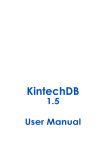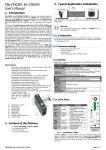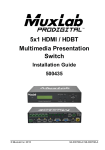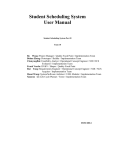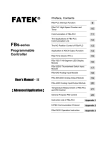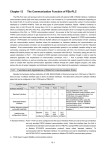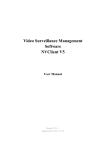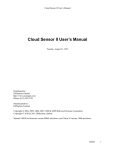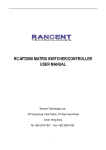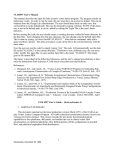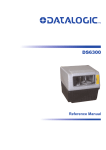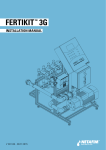Download FBs-CM25/CM55/CBE Ethernet Module User`s Manual
Transcript
FBs-CM25/CM55/CBE Ethernet Module User’s Manual Ve r. 2 . 1 Fatek Automation Corp. 7/1/2004 1. 2. Preface . . . . . . . . . . . . . . . . . . . . . . . . . . . . . . . . . . . . . . . . . . . . . . . . . . . . . . . . . . . . . . . . . . . . . . . . . . . . . . . . . . . . . 2 Specification . . . . . . . . . . . . . . . . . . . . . . . . . . . . . . . . . . . . . . . . . . . . . . . . . . . . . . . . . . . . . . . . . . . . . . . . . . . . 2 2.1 Serial Communication Connector(FBS-CM25E/CM55E only) .........2 2.2 Ethernet Serial Interface .................................................................3 3. 4. 5. Outline . . . . . . . . . . . . . . . . . . . . . . . . . . . . . . . . . . . . . . . . . . . . . . . . . . . . . . . . . . . . . . . . . . . . . . . . . . . . . . . . . . . . . . 4 The Function of Serial Port Connectors . . . . . . . . . . . . . . . . . . . . . . . . . . 5 The Function of Ethernet Serial Converter . . . . . . . . . . . . . . . . . . . . . 5 5.1Application Architecture....................................................................6 5.1.1 Server Mo de . . . . . . . . . . . . . . . . . . . . . . . . . . . . . . . . . . . . . . . . . . . . . . . . . . . . . . . . . . . . . . . . . . . . . . . 6 5.1.2 Cli e nt Mod e . . . . . . . . . . . . . . . . . . . . . . . . . . . . . . . . . . . . . . . . . . . . . . . . . . . . . . . . . . . . . . . . . . . . . . . . 8 5 . 2 H a r d w a r e I n s ta l l a t i o n . . . . . . . . . . . . . . . . . . . . . . . . . . . . . . . . . . . . . . . . . . . . . . . . . . . . . . . . . . . . . . . . . . . . 1 0 5.2.1 DIP Switch Setting ............................................................... 10 5 . 2 . 2 C a b l e W i r i n g . . . . . . . . . . . . . . . . . . . . . . . . . . . . . . . . . . . . . . . . . . . . . . . . . . . . . . . . . . . . . . . . . . . . . . . 11 5 . 3 S o ft w a r e C o n f i g u r a t i o n . . . . . . . . . . . . . . . . . . . . . . . . . . . . . . . . . . . . . . . . . . . . . . . . . . . . . . . . . . . . . . . . . . 1 2 5.3.1 Con figura tion So ft ware and i ts F u nction . . . . . . . . . . . . . . . . . . . . . . . . . . . . 1 2 5.3.2 Con figura tion thru Local Are a Net work . . . . . . . . . . . . . . . . . . . . . . . . . . . . . . 1 3 5.3.3 Con figura tion thru Int ernet . . . . . . . . . . . . . . . . . . . . . . . . . . . . . . . . . . . . . . . . . . . . . . . . 1 3 5.3.4 Co mmo n Da ta Setu p . . . . . . . . . . . . . . . . . . . . . . . . . . . . . . . . . . . . . . . . . . . . . . . . . . . . . . . . . 1 4 5.3.5 S ec uri t y Set u p . . . . . . . . . . . . . . . . . . . . . . . . . . . . . . . . . . . . . . . . . . . . . . . . . . . . . . . . . . . . . . . . . . 1 6 5 . 3 . 6 Sta ti o n & I P m a p p i n g S e t u p . . . . . . . . . . . . . . . . . . . . . . . . . . . . . . . . . . . . . . . . . . . . . . 1 8 5.3.7 Service Port Setup ............................................................ 20 5.3.8 Upd ate Con fig uratio n . . . . . . . . . . . . . . . . . . . . . . . . . . . . . . . . . . . . . . . . . . . . . . . . . . . . . . . . 2 0 5.4 Procedures to change the configuration .......................................... 20 6. Appendices . . . . . . . . . . . . . . . . . . . . . . . . . . . . . . . . . . . . . . . . . . . . . . . . . . . . . . . . . . . . . . . . . . . . . . . . . . . . . . . . . . . . 2 1 A RS232 port signal ......................................................................... 21 B RS485 port signal diagram ............................................................ 21 C FAT E K / T C P / U D P C o m m u n i c a t i o n P r o t o c o l . . . . . . . . . . . . . . . . . . . . . . . . . . . . . . . . . . . . . . . 2 1 D Modbus/TCP Communication Protocol ............................................ 21 1 1. Preface The network communication with its flexible connectivity and mobility can easily penetrate the barrier of the information island. Though at early days, most of the network systems are deployed in commercial environment, but as the evolution of the manufacture technology, the requirement of CIM/CAM is prevailing. To reach this goal how to provide a reliable and accessible medium is a key. Because the network communication has the characteristics as demand, so can be found nowadays in the industrial segment and used to bridge the communication between the management level and field level. To meet this trend, FATEK provides a series of Network interface modules, with which an economic and effective network solution for FATEK FBs-PLC can be obtained. Besides the network function, some of the modules also provide an additional serial communication port for application. 2. Specification 2.1 Serial Communication Connector(FBs-CM25E/CM55E only) 2.2 Module FBs-CM25 FBs-CM55 FBs-CBE Port Signal Type Connector port3 RS232 DB9M port4 RS485 Euro. 3pin Con. Ethernet 10BaseT Euro. 4pin Con. port3 RS485 Euro. 3pin Con. port4 RS485 Euro. 3pin Con. Ethernet 10BaseT Euro. 4pin Con. Ethernet 10BaseT RJ45 Note 1: Powered by CPU module 2 Pow er 1 200ma 200ma 150ma 2.2 Ethernet Serial Interface Characteristics Network Interface Description 1 0 B a s eT, I E E E 8 0 2 . 3 Tra n s m i s s i o n Protocol TC P, U D P, I P, A R P Application Protocol FA CO N / TC P / U D P, M o d b u s / TC P In d i c a t o r s L i n k L E D, Tra n s m i t L E D Re c e i v e L E D Signal Connector Euro. 4pin Connector C P U C o n n e c t e d Po r t Po r t 4 ( C M 2 5 E / C M 5 5 E ) Po r t 1 & Po r t 2 ( C B E ) CPU Connected Speed 9600,19200,38400,57600,115200,230400(CM25E/CM55E) S e c u r i ty M e c h a n i s m Authorized IP Authorized IP Group 10 Po r t M a p g r o u p 18 C o n f i g u ra t i o n To o l W i n d o w s - b a s e d c o n f i g u ra t i o n s o f t w a r e TC P C o n n e c t i o n s Max. 8 connections simultaneous 115200(CBE) 3 3. Outline The outline of FBs-CM25E/CM55E module is shown below 9 9 1 TX 2 RX PORT4 (RS485) + TX LNK 6 4 3 1 TX 2 RX PORT4 (RS485) 3 RUN ETHERNET ETHERNET RUN + TX LNK 6 2 RX 5 G T N 4 2 RX G 5 T N 6 3 3 7 PORT3 (RS485) PORT3 (RS232) TX RX + TX G RX T 7 N 8 FBs-CM25E FBs-CM55E and described at follow: 1 E t h e r n e t c o n n e c t o r : To m e e t t h e a n t i - v i b r a t i o n r e q u i r e m e n t o f i n d u s t r i a l environment, instead of using regular RJ-45 connector but using Euro. 4 pin p l u g c o n n e c t o r. 2 port4 connector: The signals in this connector is RS485 level. 3 port3 connector: The signals in this connector can be RS232(CM25E) or RS485(CM55E). This port is a general purpose communication port 4 Network indicators: LINK: Lit, when the Ethernet cable is properly working. RX: Lit, when detecting a signal activity of the Ethernet. TX: Lit, when the module is sending a message into the Ethernet. 5 S e r i a l p o r t s ta t u s i n d i c a t o r s : RX: Lit, when detecting a signal activity of the serial port. TX: Lit, when the module is sending a message into the serial port. 4 4. The Function of Serial Port Connectors Port3 Connector: The signal level of Port3 connector is of RS232(CM25E) or RS485(CM55E). This port can be treated as a general communication port of CPU module and used for peripheral applications. Port4 Connector: The signal level of Port4 connector is of RS485(CM55E). The main function of this port is to couple the Ethernet signal to CPU module, this port also can be treated as a general communication port of CPU module and used for peripheral applications. Whenever the FBs-CMX5E module receive a data packet from the Ethernet interface, the same data packet also will appear at this port(Ethernet to serial port conversion). On the contrary, if a data packet is received at this port and the destination is due for network (by lookup mapping table), it will also appear at Ethernet network. Because the multi-drop characteristic of RS485 interface, install one FBs-CMX5E can provide more than one PLC to hook on Ethernet. 5. The Function of Ethernet Serial Converter The operation principle of Ethernet serial converter is to take this module as interface and receive all the messages from network that intend to the PLCs managed by this module then convert it to the serial signal that can be accepted by PLC and transmit it thru port4. The operation is completely transparent, in other words, The CPU cannot distinguish the message is from local or network, the reply message is the same with normal RS232communication. When the FBs-CMX5E or FBs-CBE module(for clarity it will be referred as Ethernet module in following context) receives the reply message of PLC will pack the message into network data packet then send it to the network . It must emphasis here that the network environment is complicated and not adequate for real time d ata t r ansf er a nd ca n b e u s e m a in l y f o r m o n i t o r in g b ut n o t f o r c o n t r o l . The main reason to use the network for factory communication is for its connectivity. The application, which required to access one processor at same time by multiple clients, previous was difficult to implement by RS232 and RS485 can now easily achieve by network solution . 5 5.1Application Architecture Base on the different requirements of network application this module provides two operating modes –Server Mode and Client Mode. When operates at server mode, the Ethernet module will wait for the message coming from the network. After decode the received message it will send the message thru serial port to the PLC main unit. The reply message from the PLC will intercept by this module and packed into data packet then transmit to the network hence complete a server mode transaction. When operates at client mode, the Ethernet module will wait for the message coming from the serial port. If the received message is for the PLC located at the remote site connected by network, the Ethernet module will pack the message into data packet for network transmission and send it to network. After send the message to network the Ethernet module will wait for the reply message coming from network, when it receives the reply message it will direct the message to serial port for PLC hence complete a client mode transaction. The network connection of Ethernet module depicted in the figures at following chapter, for clarity, will only be drawn by a direct link. Actually the network interface of the Ethernet module is 10BaseT, which should attach with Hub in order to connect with network. 5.1.1 Server Mode When operates at server mode, the direct connected single PLC or the stations connected by RS485 are all work at slave mode, which will wait for command message passively and reply the command. Follows are example of server mode application 6 The example illustrate on above is the simplest server mode application. Work station A and work station B are master that can send the command message actively to FBs-PLC, Upon receiving the command message, Ethernet module will send the message thru the port4 to FBs-PLC. When there are more than one message intended to send to FBs-PLC, the Ethernet module will save the additional messages into the message queue then send it to FBs-PLC in orders (Must wait for the reply message before send the next command) therefore there will no conflicts. When work at this mode, there is no need to write any program in PLC for operation. Multiple PLC connection Under this application architecture, The PLCs connect the Ethernet module with the RS485 interface of port4. The work station A and work station B are master that can send the command message actively to FBs-PLC, Upon receiving the command message from the network, Ethe rne t mo dule wi ll re-se nd the mess a ge to FBs -PL C t hru port4 inte rface . When the message appears at RS485 line, each PLC will compare the target station embed in message against its own station ID. If the result is true then it will reply according to the command message. The reply message will intercept by the Ethernet module and re-pack then send to the network. When there are more than one message intended to send to FBs-PLC, the Ethernet module will save the additional messages into the message queue then send it to FBs-PLC in orders (Must wait for the reply message before send the next command) therefore will not have conflicts . 7 When work at this mode, there is no need to write any program in PLC for operation. 5.1.2 Client Mode While work at client mode, the Ethernet module will wait the command message at port4. When it finds the message is for the PLC station located at remote site(Please refer section 5.3.6 for setting) then it will pack the message according to the content of port mapping table and send it to the network. After that, Ethernet module will keep an eye on network for the reply message. Upon receiving the reply message, the Ethernet module will decode the message then send back to PLC thru serial port hence complete a client mode transaction. When work at this mode, the direct connected single PLC or the master station of PLC LINK connected by RS485 interface are all operated at master mode, which means it use LINK instruction mode0 to send the command actively. The client mode also can be further divided into standard mode and virtual server mode. Explanation as follows 5 . 1 . 2 . 1 Sta n d a r d C l i e n t M o d e When work at this mode, the master PLC connected with Ethernet module can use L INK inst ru ction mo d e0 send t he co mma nd messa ge to othe r PL C. The target PLC that master PLC intend to command can be a local slave PLC connected by RS485 interface to master PLC or a PLC located at remote site with sever mode Ethernet connection. There is a “Station to network address translation table” in the Ethernet module when work at client mode. This table includes the information about the mapping of local station and remote station, the user should set this table according to the actual application deployment (Please refer section 5.3.6 for table setting). While operation, the Ethernet module will constantly inspect the received message, if the station number in the message can be found in the translation table that means the message is going to route to network, the Ethernet module will first replace the station number in message according to the translation table then re-calculate and update the check sum of translated message and encapsulate it in network data packet and finally send it to the network. After received the reply message from 8 network, the Ethernet module will perform the translation of message at the reverse order. First it will replace station number in message to the original station number and then re-calculate and update the check sum of message then send it to serial port. A standard client mode network application is shown as follows. In the above figure, there are two groups of PLC. The PLCs in each group are linked together by RS485 interface and then attach to an Ethernet module for network accessibility. The station number 1 of group 1 is a master PLC, which not only can access the other PLCs of same group but also can access the PLCs of group 2 with the help of two Ethernet modules bridging. The Ethernet module attached to group 2 PLC is configured as server mode, which means all the PLCs covered by this module are work as slave PLC and wait for the command passively. It must emphasis that the PLCs under standard client mode Ethernet module can’t access by other master devices thru network communication. The role of this kind of Ethernet module is very similar to Fire Wall. Only the messages from inside or the corresponding reply messages can be accepted by Ethernet module, other messages will be blocked. The security of client mode operation is very high. Based on the reason described above, the workstation A can only access the PLCs of group 2 . It’s noted that, from the view point of master PLC, the station number of station #2 of group 2 is not 2, otherwise it can’t distinguish it from the local station of #2. This can be overcame by the introduction of translation table. 9 5 . 1 . 2 . 2 Vi r t u a l S e r ve r M o d e Though high security is the key feature of standard client mode, can’t accessed by other devices thru network is also a drawback. To take the balance between the security and connectivity, the Ethernet module provides a virtual server mode to meet the both end. While working at this mode, the Ethernet module emulates a PLC with station number of 255. There are only R0~R1999 can be accessed of this virtual PLC. When the command message is for station 255, the Ethernet module will interpret the message and act upon that message; this is true for all the messages whether it comes from serial port or from network. The Ethernet module act as a medium, the status of PLCs can store in it for outside world access. The outside world can put the command status in it for PLCs access. The virtual server mode is an option for client working mode, which means while act as virtual server the master PLC still can access the slave PLCs that attached to network. 5.2 Hardw are Installation 5.2.1 DIP Sw itch Setting 5.2.1.1 Termination resistor installation(FBs-CM25E/CM55E) In order to meet the termination requirement of RS485 network, all Ethernet modules equip with a set of built-in termination resistor to ease the field installation. The termination function can be setup by the DIP switch seen from the front cover as follow. T N When both switches are at T position, it means termination resistor is in effective. When at N position means no termination resistor attached by this module. When implementation, there are only two modules that located at opposite far side need to terminated. Excessive termination will over load the whole network thus must be avoided. 5.2.1.2 Password protection setup When the password has been entered (enabled), the user will be requested to enter a matched password each time when perform the configuration via configuration utility ‘ether_cfg.exe’. In other words, in case the user forget the password then he/she no longer can modify the module’s configuration. To prevent this situation from occuring, there also 10 provides a jumper to disable the password protection temporary. This jumper can be accessed only when the module’s plastic cover is removed. The relative location of jumper is depicted at follow: JP1 NO PASS When the jumper cap of JP1 is at upper position (linked by white line), the password protection is disabled. The jumper cap should put in the lower position when under normal operation. 5.2.2 Cable Wiring Serial port connectors: Please refer Appendix A, B for the Port3, Port4 signal description. Netw ork connector: The connector type of FBs-CM25E/55E is Euro 4pin plug connector while FBs-CBE board is RJ-45. Please use the CAT5 UTP (un-shielded twisted pair) cable for network connection. The best recommendation is using the CAT5 STP(shielded twisted pair) cable 。 The wiring of cable to network connector is listed as below. Signal TX+ TXRX+ RX- Wire Color White-Orange Orange White-Green Green Euro -4 Pin 3 4 1 2 11 RJ-45 1 2 3 6 Direction Output← Output← Input→ Input→ 5.3 Softw are Configuration 5.3.1 Configuration Softw are and its Function T h e r e i s a a c c o m pa n y s o ft w a r e ”Ether_cfg.exe” to aid the configuration of Ethernet module. This software is a windows-based software and has following functions: Basic module Information setup- Includes IP (Network address), gateway, netmask, baud rate, operating mode, module name, module description. Security setup- Setup authorized IP. With this function, only the command message issue by the host with authorized IP can be accepted by Ethernet module. Hence can prevent the unintended access and keep the system secure. There are 10 set of IP group can be set. Each group can contain one or more consecutive IPs. Local station to remote station mapping- The operating of FBs-PLC networking is purely transparent. When access the remote slave PLC by executing the LINK instruction of mode0 and with the help of Ethernet module, the master PLC does not know the remote PLC is connected by network. In other words, the maximum number of slave station is still 254. When Ethernet module work at client mode, in order to translate the local station into remote station, must first setup the translation table. Considering the convenience for variety application, there are three methods can be used to setup the network configuration. Setup by local area netw ork – This is the most convenient method for network configuration. When operating, the configuration software will scan all the Ethernet modules attached to the network. All the scanned Ethernet modules will be shown in the table on the screen with the regarded basic information. The user can pick the Ethernet module to be editing directly from the screen. Considering the security, we can set the password to prevent the unintended access. Please refer section 5.3.5 for detail explanation. 12 Setup by Internet – With this method can setup the network configuration thru Internet. Most often is used to setup the station mapping or authorized IP. While use this method, can only setup one Ethernet module at a ti me and mus t specif y th e IP add ress of Et h ernet mod ule t o be edited . Considering the security, can set password to prevent the unintended access. Please refer section 5.3.4 for detail explanation. 5.3.2 Configuration thru Local Area Netw ork Step 1. Use the network cable to connect the Ethernet module and Hub. Step 2. Connect the PC to network and execute the software Ether_cfg.exe . Use the mouse click the ’Intranet’ option in the ’Configuration Channel’ group box, then the screen changes to Click the ’Scan Map’ button then start the scanning of Ethernet module. All the modules detected will be shown in the table. The remaining procedures will be left until section 5.3.4. 5.3.3 Configuration thru Internet Step 1. Connect the Ethernet module and Hub with twisted Ethernet cable. Step 2. Connect the PC to network and execute the network configuration 13 software - ether_cfg.exe. Use the mouse point to the ’Internet’ option buttons within the ’Configuration Channel’ group box and click it then the screen will be shown as below At this time can input the remote IP address of the Ethernet module desired for configuration. After click the ‘Get Map’ button, it will start to connect Ethernet module. When the connection is established will show the information regard the connected Ethernet module in the table at the middle of window. 5.3.4 Common Data Setup Whenever the connection is established, it will show the information regard the connected Ethernet module in the table at the middle of window, no matter what the connection method is selected. 14 At that time, can double click the line where the desired Ethernet module is located or single click the line and click ’Properties..’ button to perform the configuration. If password not setting or correct password were entered will show the screen as below Follows are the description of each field shown in above Firmw are Version: Denotes the software version of Ethernet module for configuration. IP Address: IP address of Ethernet module for configuration. Subnet Mask: Subnet mask of Ethernet module for configuration. Gatew ay: The IP address of gateway for Ethernet module for configuration. Host Name: For documentation, can be used to distinguish Ethernet module. At most can consist of 11 characters. Comment: For documentation, can be used to distinguish Ethernet module. At most can consist of 21 characters. Operation mode: Client or server mode selection. Protocol: There are two communication protocols were supported in this module. Modbus/TCP or Fatek. Modbus/TCP can be choosed only when the operation mode is set to Server mode while the Fatek mode can be used in both modes. Baud Rate(CM25E/CM55E): Communication speed between Ethernet module and PLC with 9600, 19200, 38400,57600,115200,230400 bps s i x options 。 Remote Config. Enabled: For security, when this option is checked will allow the configuration thru the Internet. It must be checked when intent to configure the network configuration according to the method described in section5.3.4. It’s strongly recommended to set the password when 15 enable the remote configuration to prevent the leakage of security hole. Please leave this option un-checked if remote configuration is not necessary. Import-Export button: Can use the Export function to save entire setup data of Ethernet module to file or use the Import function to retrieve the setup data stored in file to ease the editing job of configuration. The contents enclose in the box at below can be skipped for the beginner Advanced Setup: This setting can only need to be performed when at server mode, click ’Advance Setup’ button to start setup and the screen will be shown Message Time Out: The time-out time for PLC, the default setting is 300ms. Ethernet module will wait for the same amount time of this field before the PLC can reply the command message. Transaction delay: The minimal delay time for Ethernet module to send the next command message after it receives a reply message from PLC. The default setting is 0ms. This setting is used for the applications that connect multiple PLCs with diverse scan time by RS485. 5.3.5 Security Setup For security of Ethernet module operation, besides the disable/enable control of remote configuration, also provides following measures to work with Passw ord Protection- Continues from last screen, click the ’Password’ tab to set the password. The screen changes to 16 Please input the new password at ’New Password’ and ’Confirm Password’ edit field and click the ’Change’ button to complete the setting of new password. Please click the ’Remove’ button if password protection is not necessary. The setting of access right- Use the setting of authorized IP to prevent the illegal access of data. After click the ’Access Control’ tab, the screen changes to Move the cursor to the ‘Grant IP’ table and click the right mouse button then the screen will appear a pop-up menu as shown below Click ’Add’ to add one set of authorized IP. Click ’Del’ to delete a set of authorized IP. Click ‘Edit’ to modify an existed authorized IP data. After click the ’Add’ function the screen changes to 17 With this dialog to define a set of consecutive authorized IP addresses. Please input the first IP address of the consecutive IP addresses in the ’Grant IP’ field and input the size of IP addresses in ‘Group Size’ filed. 5.3.6 Station & IP mapping Setup This setting can only need to perform when Ethernet module is work at client mode. When the working mode is set to client mode the basic configuration data page changes to It has an additional ‘Port Mapping’ tab when compare with server mode, after click the ‘Port Mapping’ tab the screen changes to 18 Move the cursor to the table locating in the center of window then click the right mouse button then the screen appears a pop-up menu as shown below Click ’Add’ to add one station mapping data. Click ’Del’ to delete a station mapping data. Click ‘Edit’ to modify an existed station mapping data. After click the ’Add’ command the screen changes to Following are the description of each field shown in above Local Station: The station number of local PLC Remote Station: The station number of remote PLC Remote IP: The IP address of Ethernet module connected by the remote PLC. Group Size: With execute this dialog once can define a group of station mapping, for example, if we want to map the local PLC station number 20~29 to remote PLC station10~19 and the IP Address of remote Ethernet module is 192.168.1.3 then can set the Local Station to 20, Remote Station to 10, Group Size to 10, Remote IP to 192.168.1.3. The Ethernet 19 module can provide at most 19 groups of station mapping. 5.3.7 Service Port Setup The Ethernet module when work either in TCP or UDP server mode should be assigned a service port number for client access. The default port number for FBs series Ethernet module is port 500. If the user want to change the port n u m b e r c a n c l i c k t h e ‘ M I S C ’ ta b a n d c h a n g e t h e M a j o r p o r t f i e l d t o d e s i r e p o r t n u m b e r. S e c o n d p o r t f i e l d p r o v i d e s t h e U D P w o r k i n g m o d e t h e o p p o r t u n i t y t o h a v e d u a l s e r v i c e p o r t n u m b e r, o n e i s p o r t 5 0 0 t h e o t h e r i s p o r t n u m b e r a p p e a r in Major port field. 5.3.8 Update Configuration When finish the editing of configuration data, please click the ’OK’ button of the “adaptor ’s properties” window to update the Ethernet module. When finish the update and without error, the screen will change to main window and ready for configuration of another Ethernet module. 5.4 Procedures to change the configuration Now summarize the procedures to change the network configuration at below. Step 1. Choose the connection method. If Local area network refer section 5.3.2 . If Internet refer section 5.3.3 . Step 2. Edit the basic network data, please refer section 5.3.4 . Step 3. Setup the password (optional), please refer section 5.3.5 . Step 4. Setup the authorized IP (optional), please refer section 5.3.5 . Step 5. Setup the mapping of local and remote station and IP address (Only client mode required), please refer section 5.3.6 . 20 6. Appendices A RS232 port signal Signal RX TX GND B Pin 2 3 5 Flow Input→ Output← RS485 port signal diagram RTX+ RTXGND C FATEK/TCP/UDP Communication Protocol The communication protocol of FATEK TCP/UDP embeds the FATEK serial communication message in the TCP or UDP data packet. The port number used to convey the FATEK TCP/UDP message is configurable (default is 500, refer 5.3.7 for detail). D Modbus/TCP Communication Protocol The document of communication protocol of Modbus/TCP can be referenced at the web site http://www.modbus.org . The port number used to convey the Modbus/TCP message is 502. 21























